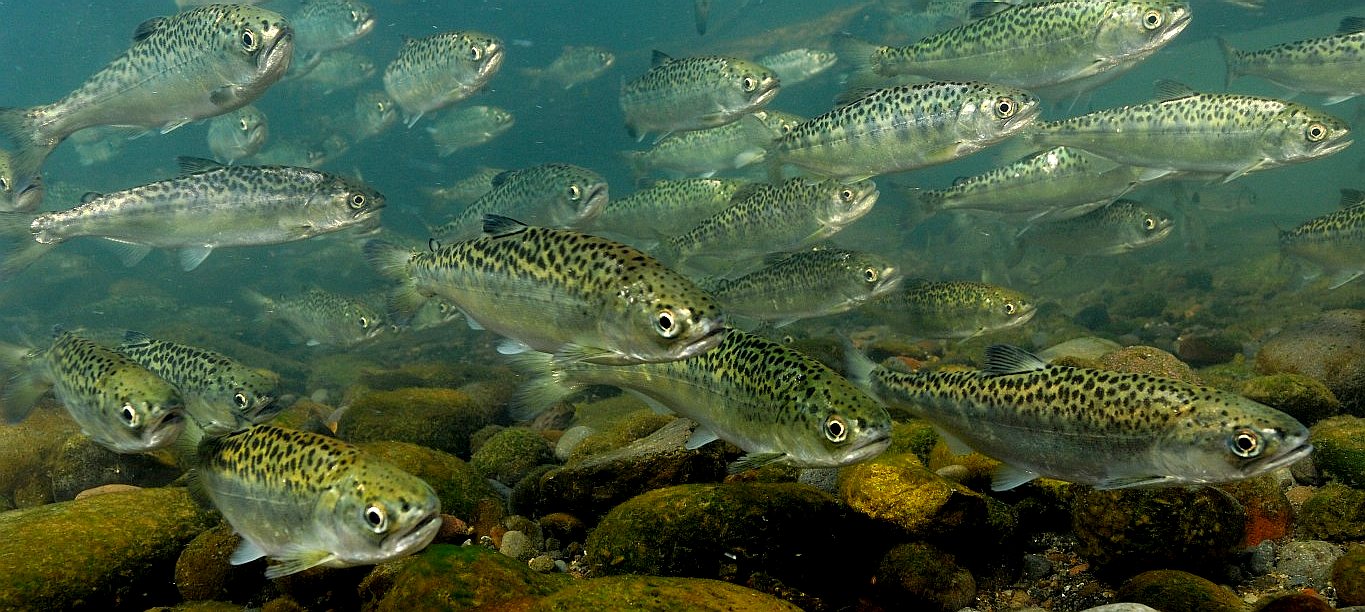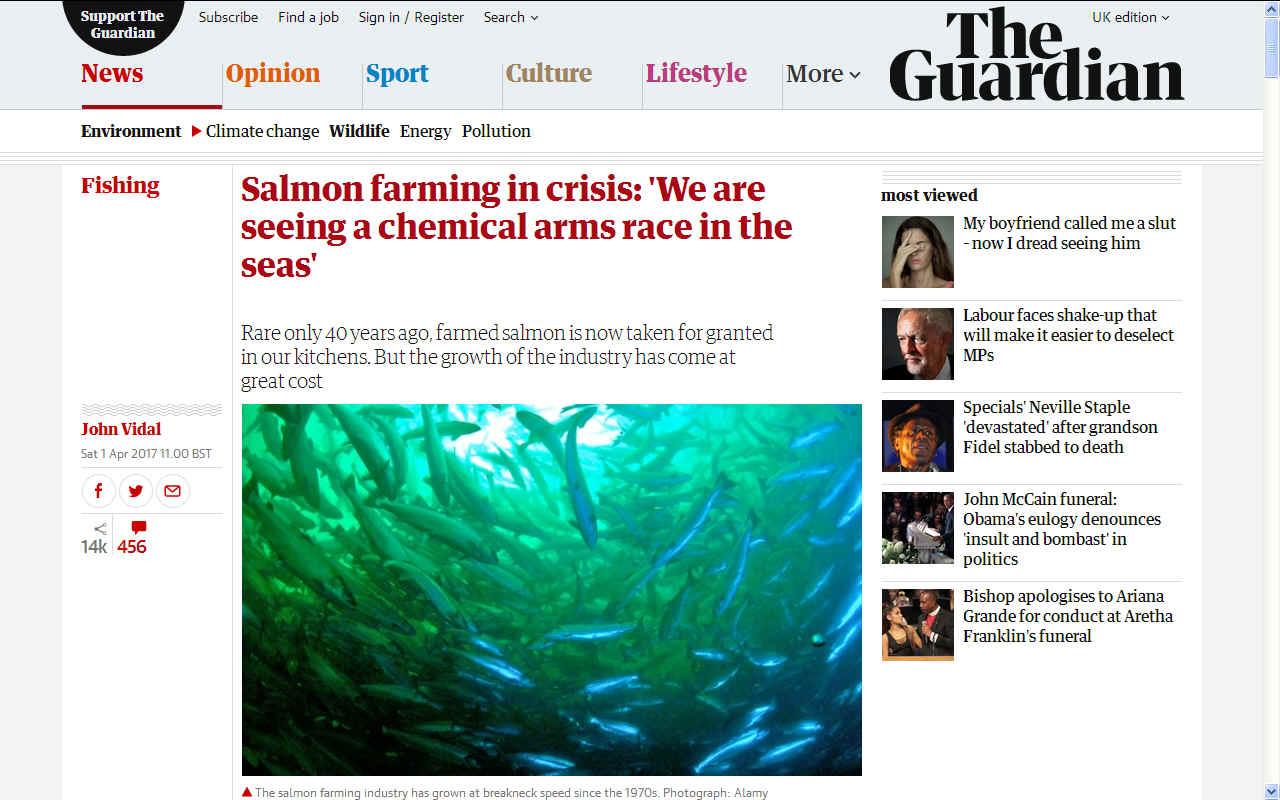|
SALMON
ABOUT - HOME- WHALING - A-Z INDEX
Anchovies
| Bass
| Bream
| Catfish
| Clams
| Cod
Coley
| Crabs
| Crayfish
| Eels
| Grouper
| Haddock
| Hake
| Halibut
| Herring
| Jellyfish
Krill
| Lobster
| Mackerel
| Marlin
| Monkfish
| Mullet
| Mussels
| Oysters
| Perch
| Plaice
| Pollock
| Prawns
| Rays
| Sablefish
| Salmon
Sardines
| Scallops
| Sharks
| Shrimp
| Skate
| Sole
| Sprat
| Squid
| Sturgeon
| Swordfish
| Trout
| Tuna
| Turbot
| Whiting

SALMON
- Is a favorite with aqua culturists all over the world as a
high value fish.
In
an effort to feed a
growing population we should look at
alternatives lower down the food chain to increase the ratio
at which protein is harvested from the ocean, so bypassing the
conventional food chain where at each stage of consumption
there are significant losses in the conversion process. Jellyfish,
squid, krill
and filter feeders such a mussels could play a part in filling the widening gap between falling
fish stocks and higher demand to feed humans - so
relieving the pressure on tuna, salmon and other popular white
fish.

ABOUT
SALMON
Salmon is a popular food. Classified as an oily fish,[90] salmon is considered to be healthy due to the fish's high protein, high omega-3 fatty acids, and high vitamin D content. Salmon is also a source of cholesterol, with a range of 23–214 mg/100 g depending on the species. According to reports in the journal Science, farmed salmon may contain high levels of
dioxins. PCB (polychlorinated biphenyl) levels may be up to eight times higher in farmed salmon than in wild salmon, but still well below levels considered dangerous. Nonetheless, according to a 2006 study published in the Journal of the American Medical Association, the benefits of eating even farmed salmon still outweigh any risks imposed by contaminants. Farmed salmon has a high omega 3 fatty acid content comparable to wild salmon. The type of omega-3 present may not be a factor for other important health functions.
Salmon flesh is generally orange to red, although white-fleshed wild salmon with white-black skin colour occurs. The natural colour of salmon results from carotenoid pigments, largely astaxanthin, but also canthaxanthin, in the flesh. Wild salmon get these carotenoids from eating krill and other tiny shellfish.
The vast majority of Atlantic salmon available around the world are farmed (almost 99%), whereas the majority of Pacific salmon are wild-caught (greater than 80%). Canned salmon in the US is usually wild Pacific catch, though some farmed salmon is available in canned form. Smoked salmon is another popular preparation method, and can either be hot or cold smoked. Lox can refer to either cold-smoked salmon or salmon cured in a brine solution (also called gravlax). Traditional canned salmon includes some skin (which is harmless) and bone (which adds calcium). Skinless and boneless canned salmon is also available.
Raw salmon flesh may contain Anisakis nematodes, marine parasites that cause anisakiasis. Before the availability of refrigeration, the Japanese did not consume raw salmon. Salmon and salmon roe have only recently come into use in making sashimi (raw fish) and sushi.
To the Indigenous peoples of the Pacific Northwest Coast, salmon is considered a vital part of the diet. Specifically, the indigenous peoples of Haida Gwaii, located near former Queen Charlotte Island in British Columbia, rely on salmon as one of their main sources of food, although many other bands have fished Pacific waters for centuries. Salmon are not only ancient and unique, but it is important because it is expressed in culture, art forms, and ceremonial feasts. Annually, salmon spawn in Haida, feeding on everything on the way upstream and down. Within the Haida nation, salmon is referred to as "tsiin", and is prepared in several ways including smoking, baking, frying, and making soup.
Historically, there has always been enough salmon, as people would not overfish, and only took what they needed. In 2003, a report on First Nation participation in commercial fisheries, including salmon, commissioned by BC’s Ministry of Agriculture, Food and Fisheries found that there were 595 First Nation-owned and operated commercial vessels in the province. Of those vessels, First Nations’ members owned 564. However, employment within the industry has decreased overall by 50% in the last decade, with 8,142 registered commercial fishermen in 2003. This has affected employment for many fisherman, who rely on salmon as a source of income.
Black bears also rely on salmon as food. The leftovers the bears leave behind are considered important nutrients for the Canadian forest, such as the soil, trees, and plants. In this sense, the salmon feed the forest and in return receive clean water and gravel in which to hatch and grow, sheltered from extremes of temperature and water flow in times of high and low rainfall. However, the condition of the salmon in Haida has been affected in recent decades. Due to logging and development, much of the salmon's habitat (i.e., Ain River) has been destroyed, resulting in the fish being close to endangered. For residents, this has resulted in limits on catches, in turn, has affected families diets, and cultural events such as feasts. Some of the salmon systems in danger include: the Davidon, Naden, Mamim, and Mathers. It is clear that further protection is needed for salmon, such as their habitats, where logging commonly occurs.
AQUACULTURE
Salmon aquaculture is a major contributor to the world production of farmed finfish, representing about US$10 billion annually. Other commonly cultured fish species include: tilapia, catfish, sea bass, carp and bream. Salmon farming is significant in Chile, Norway, Scotland, Canada and the Faroe Islands; it is the source for most salmon consumed in the United States and Europe. Atlantic salmon are also, in very small volumes, farmed in Russia and the island of Tasmania, Australia.
Salmon are carnivorous. They are fed a meal produced from catching other wild fish and other marine organisms. Salmon farming leads to a high demand for wild forage fish. Salmon require large nutritional intakes of protein, and farmed salmon consume more fish than they generate as a final product. To produce one pound of farmed salmon, products from several pounds of wild fish are fed to them. As the salmon farming industry expands, it requires more wild forage fish for feed, at a time when 75% of the world's monitored fisheries are already near to or have exceeded their maximum sustainable yield. The industrial-scale extraction of wild forage fish for salmon farming affects the survivability of the wild predator fish which rely on them for food.
On a dry weight basis, 2–4 kg of wild-caught fish are needed to produce one kg of salmon.
Another form of salmon production, which is safer but less controllable, is to raise salmon in hatcheries until they are old enough to become independent. They are released into rivers in an attempt to increase the salmon population. This system is referred to as ranching. It was very common in countries such as Sweden, before the Norwegians developed salmon farming, but is seldom done by private companies. As anyone may catch the salmon when they return to spawn, a company is limited in benefiting financially from their investment.
Because of this, the ranching method has mainly been used by various public authorities and nonprofit groups, such as the Cook Inlet Aquaculture Association, as a way to increase salmon populations in situations where they have declined due to
over-harvesting, construction of dams, and habitat destruction or fragmentation. Negative consequences to this sort of population manipulation include genetic "dilution" of the wild stocks. Many jurisdictions are now beginning to discourage supplemental fish planting in favour of harvest controls, and habitat improvement and protection.
A variant method of fish stocking, called ocean ranching, is under development in Alaska. There, the young salmon are released into the ocean far from any wild salmon streams. When it is time for them to spawn, they return to where they were released, where fishermen can catch them.
An alternative method to hatcheries is to use spawning channels. These are artificial streams, usually parallel to an existing stream, with concrete or rip-rap sides and gravel bottoms. Water from the adjacent stream is piped into the top of the channel, sometimes via a header pond, to settle out sediment. Spawning success is often much better in channels than in adjacent streams due to the control of floods, which in some years can wash out the natural
reds. Because of the lack of floods, spawning channels must sometimes be cleaned out to remove accumulated sediment. The same floods that destroy natural
reds also clean the regular streams. Spawning channels preserve the natural selection of natural streams, as there is no benefit, as in hatcheries, to use prophylactic chemicals to control diseases.
Farm-raised salmon are fed the carotenoids astaxanthin and canthaxanthin to match their flesh colour to wild salmon to improve their marketability.
One proposed alternative to the use of wild-caught fish as feed for the salmon, is the use of soy-based products. This should be better for the local environment of the fish farm, but producing soy beans has a high environmental cost for the producing region. The fish omega-3 fatty acid content would be reduced compared to fish-fed salmon.
Another possible alternative is a yeast-based coproduct of bioethanol production, proteinaceous fermentation biomass. Substituting such products for engineered feed can result in equal (sometimes enhanced) growth in fish. With its increasing availability, this would address the problems of rising costs for buying hatchery fish feed.
Yet another attractive alternative is the increased use of seaweed. Seaweed provides essential minerals and vitamins for growing organisms. It offers the advantage of providing natural amounts of dietary fiber and having a lower glycemic load than grain-based fish
meal. In the best-case scenario, widespread use of seaweed could yield a future in aquaculture that eliminates the need for land, freshwater, or fertilizer to raise fish.
LINKS
& REFERENCE
https://www.theguardian.com/environment/2017/apr/01/is-farming-salmon-bad-for-the-environment

MARINE
LIFE - This humpback whale is one example of a magnificent
animal that is at the mercy of human
activity. Humans are for the most part unaware of the harm their fast-lane
lifestyles are causing. We aim to change that by doing all we
can to promote ocean
literacy.
Anchovies
| Bass
| Bream
| Catfish
| Clams
| Cod
Coley
| Crabs
| Crayfish
| Eels
| Grouper
| Haddock
| Hake
| Halibut
| Herring
| Jellyfish
Krill
| Lobster
| Mackerel
| Marlin
| Monkfish
| Mullet
| Mussels
| Oysters
| Perch
| Piranha |
Plaice
| Pollock
| Prawns
| Rays
| Sablefish
| Salmon
Sardines
| Scallops
| Sharks
| Shrimp
| Skate
| Sole
| Sprat
| Squid
| Sturgeon
| Swordfish
| Trout
| Tuna
| Turbot
| Whiting
This
website is provided on a free basis as a public information
service. Copyright © Cleaner
Oceans Foundation Ltd (COFL) (Company No: 4674774)
2022. Solar
Studios, BN271RF, United Kingdom.
COFL
is a charity without share capital.
|


